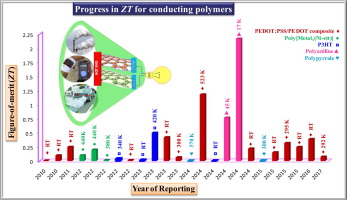当前位置:
X-MOL 学术
›
Prog. Mater. Sci.
›
论文详情
Our official English website, www.x-mol.net, welcomes your
feedback! (Note: you will need to create a separate account there.)
Conductive polymers: Creating their niche in thermoelectric domain
Progress in Materials Science ( IF 33.6 ) Pub Date : 2018-04-01 , DOI: 10.1016/j.pmatsci.2017.09.004 Meetu Bharti , Ajay Singh , Soumen Samanta , D.K. Aswal
Progress in Materials Science ( IF 33.6 ) Pub Date : 2018-04-01 , DOI: 10.1016/j.pmatsci.2017.09.004 Meetu Bharti , Ajay Singh , Soumen Samanta , D.K. Aswal

|
Abstract In spite of the fact that conducting polymers, during the past decade, have made inroads into various flexible devices including electronics, supercapacitors, sensors, transistors and memories etc. their exploration in the field of thermoelectric power-generation has not yet been significant. This review provides a comprehensive study regarding thermoelectric performance of various conducting polymers depending upon their specific structural and physico-chemical properties. Recent trends in organic thermoelectrics are discussed as: (i) factors affecting thermoelectric performance; (ii) strategies required for improvement of the power factor (due to inherent low thermal conductivity); and (iii) challenges that still lie ahead. A detailed analysis of electrical and thermal transport-mechanisms suggests that various processes such as stretching, controlled doping and addition of inorganic materials/carbon nanostructures, may be applied for enhancement of the thermoelectric figure-of-merit. The attempts are made for highlighting as to how these conducting polymers can be realized into efficient thermoelectric generators by summarizing various reported architectural-designs. These devices have a tremendous potential for tapping low-temperature heat (e.g. body/appliances’ heat, geo-thermal/oceanic heat etc.) to power wearable medical sensors and smart electronic devices. Finally, the efforts are put together to familiarize the reader with the big breakthrough that can be created by light-weight, flexible, non-toxic conducting polymers in thermoelectric domain.
中文翻译:

导电聚合物:在热电领域创造自己的利基
摘要 尽管导电聚合物在过去十年中已经进入各种柔性器件,包括电子、超级电容器、传感器、晶体管和存储器等,但它们在热电发电领域的探索尚不显着。该综述提供了关于各种导电聚合物的热电性能的综合研究,具体取决于它们的特定结构和物理化学性质。有机热电的最新趋势被讨论为:(i) 影响热电性能的因素;(ii) 提高功率因数所需的策略(由于固有的低导热性);(iii) 仍然存在的挑战。对电和热传输机制的详细分析表明,可以应用各种工艺,例如拉伸、受控掺杂和添加无机材料/碳纳米结构,以提高热电品质因数。通过总结各种报道的建筑设计,试图强调如何将这些导电聚合物实现为高效的热电发电机。这些设备在利用低温热量(例如身体/电器的热量、地热/海洋热量等)为可穿戴医疗传感器和智能电子设备供电方面具有巨大潜力。最后,我们将努力让读者熟悉热电领域的轻质、柔性、无毒导电聚合物可以创造的重大突破。受控掺杂和添加无机材料/碳纳米结构,可用于增强热电品质因数。通过总结各种报道的建筑设计,试图强调如何将这些导电聚合物实现为高效的热电发电机。这些设备在利用低温热量(例如身体/电器的热量、地热/海洋热量等)为可穿戴医疗传感器和智能电子设备供电方面具有巨大潜力。最后,我们将努力让读者熟悉热电领域的轻质、柔性、无毒导电聚合物可以创造的重大突破。受控掺杂和添加无机材料/碳纳米结构,可用于增强热电品质因数。通过总结各种报道的建筑设计,试图强调如何将这些导电聚合物实现为高效的热电发电机。这些设备在利用低温热量(例如身体/电器的热量、地热/海洋热量等)为可穿戴医疗传感器和智能电子设备供电方面具有巨大潜力。最后,我们将努力让读者熟悉热电领域的轻质、柔性、无毒导电聚合物可以创造的重大突破。可用于提高热电品质因数。通过总结各种报道的建筑设计,试图强调如何将这些导电聚合物实现为高效的热电发电机。这些设备在利用低温热量(例如身体/电器的热量、地热/海洋热量等)为可穿戴医疗传感器和智能电子设备供电方面具有巨大潜力。最后,我们将努力让读者熟悉热电领域的轻质、柔性、无毒导电聚合物可以创造的重大突破。可用于提高热电品质因数。通过总结各种报道的建筑设计,试图强调如何将这些导电聚合物实现为高效的热电发电机。这些设备在利用低温热量(例如身体/电器的热量、地热/海洋热量等)为可穿戴医疗传感器和智能电子设备供电方面具有巨大潜力。最后,我们将努力让读者熟悉热电领域的轻质、柔性、无毒导电聚合物可以创造的重大突破。这些设备在利用低温热量(例如身体/电器的热量、地热/海洋热量等)为可穿戴医疗传感器和智能电子设备供电方面具有巨大潜力。最后,我们将努力让读者熟悉热电领域的轻质、柔性、无毒导电聚合物可以创造的重大突破。这些设备在利用低温热量(例如身体/电器的热量、地热/海洋热量等)为可穿戴医疗传感器和智能电子设备供电方面具有巨大潜力。最后,我们将努力让读者熟悉热电领域的轻质、柔性、无毒导电聚合物可以创造的重大突破。
更新日期:2018-04-01
中文翻译:

导电聚合物:在热电领域创造自己的利基
摘要 尽管导电聚合物在过去十年中已经进入各种柔性器件,包括电子、超级电容器、传感器、晶体管和存储器等,但它们在热电发电领域的探索尚不显着。该综述提供了关于各种导电聚合物的热电性能的综合研究,具体取决于它们的特定结构和物理化学性质。有机热电的最新趋势被讨论为:(i) 影响热电性能的因素;(ii) 提高功率因数所需的策略(由于固有的低导热性);(iii) 仍然存在的挑战。对电和热传输机制的详细分析表明,可以应用各种工艺,例如拉伸、受控掺杂和添加无机材料/碳纳米结构,以提高热电品质因数。通过总结各种报道的建筑设计,试图强调如何将这些导电聚合物实现为高效的热电发电机。这些设备在利用低温热量(例如身体/电器的热量、地热/海洋热量等)为可穿戴医疗传感器和智能电子设备供电方面具有巨大潜力。最后,我们将努力让读者熟悉热电领域的轻质、柔性、无毒导电聚合物可以创造的重大突破。受控掺杂和添加无机材料/碳纳米结构,可用于增强热电品质因数。通过总结各种报道的建筑设计,试图强调如何将这些导电聚合物实现为高效的热电发电机。这些设备在利用低温热量(例如身体/电器的热量、地热/海洋热量等)为可穿戴医疗传感器和智能电子设备供电方面具有巨大潜力。最后,我们将努力让读者熟悉热电领域的轻质、柔性、无毒导电聚合物可以创造的重大突破。受控掺杂和添加无机材料/碳纳米结构,可用于增强热电品质因数。通过总结各种报道的建筑设计,试图强调如何将这些导电聚合物实现为高效的热电发电机。这些设备在利用低温热量(例如身体/电器的热量、地热/海洋热量等)为可穿戴医疗传感器和智能电子设备供电方面具有巨大潜力。最后,我们将努力让读者熟悉热电领域的轻质、柔性、无毒导电聚合物可以创造的重大突破。可用于提高热电品质因数。通过总结各种报道的建筑设计,试图强调如何将这些导电聚合物实现为高效的热电发电机。这些设备在利用低温热量(例如身体/电器的热量、地热/海洋热量等)为可穿戴医疗传感器和智能电子设备供电方面具有巨大潜力。最后,我们将努力让读者熟悉热电领域的轻质、柔性、无毒导电聚合物可以创造的重大突破。可用于提高热电品质因数。通过总结各种报道的建筑设计,试图强调如何将这些导电聚合物实现为高效的热电发电机。这些设备在利用低温热量(例如身体/电器的热量、地热/海洋热量等)为可穿戴医疗传感器和智能电子设备供电方面具有巨大潜力。最后,我们将努力让读者熟悉热电领域的轻质、柔性、无毒导电聚合物可以创造的重大突破。这些设备在利用低温热量(例如身体/电器的热量、地热/海洋热量等)为可穿戴医疗传感器和智能电子设备供电方面具有巨大潜力。最后,我们将努力让读者熟悉热电领域的轻质、柔性、无毒导电聚合物可以创造的重大突破。这些设备在利用低温热量(例如身体/电器的热量、地热/海洋热量等)为可穿戴医疗传感器和智能电子设备供电方面具有巨大潜力。最后,我们将努力让读者熟悉热电领域的轻质、柔性、无毒导电聚合物可以创造的重大突破。











































 京公网安备 11010802027423号
京公网安备 11010802027423号